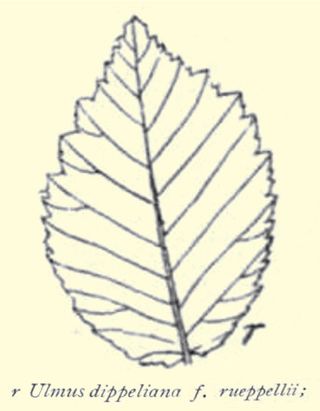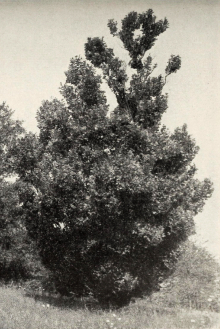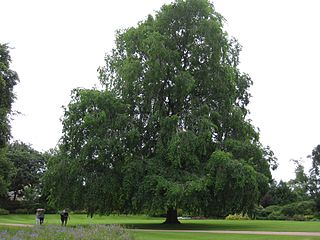
The hybrid elm cultivar Ulmus × hollandica 'Smithii', commonly known as the Downton Elm, was one of a number of cultivars arising from the crossing of the Wych Elm U. glabra with the Field Elm U. minor. The tree was originally planted at Downton Castle near Ludlow, as one of a batch, not all of them pendulous in habit, raised at Smith's Nursery, Worcester, England, from seeds obtained from a tree in Nottingham in 1810.

The putative hybrid cultivar Ulmus × hollandica 'Serpentina' is an elm of unknown provenance and doubtful status. Henry identified it as intermediate between U. glabra and U. minor, a view accepted by Bean and by Melville, who believed that the specimens at Kew bearing the name 'Serpentina' were U. glabra "introgressed by U. carpinifolia" [: U. minor] and were similar to but "distinct from 'Camperdownii'".

The Field Elm cultivar Ulmus minor 'Propendens', described by Schneider in 1904 as U. glabra (:minor) var. suberosa propendens, Weeping Cork-barked elm, was said by Krüssmann (1976) to be synonymous with the U. suberosa pendula listed by Lavallée without description in 1877. Earlier still, Loudon's Arboretum et Fruticetum Britannicum had included an illustration of a pendulous "cork-barked field elm", U. campestris suberosa. An U. campestris suberosa pendula was in nurseries by the 1870s.
The elm cultivar Ulmus 'Monstrosa' [: "monstrous", "strange"], a shrub-elm with fasciated branching, is believed to have originated in France, where it was first listed by Lavallée in Arboretum Segrezianum (1877) as a form of Field Elm, Ulmus campestris var. monstrosa, but without description. Though its long slender 2 cm petiole is not a feature of wych elm U. glabraHuds., and is even less likely in a shrub form of this species, the wych-cultivar error arose early, perhaps because the Späth nursery of Berlin, using Ulmus montana both for some Ulmus × hollandica cultivars and for wych varieties, listed it c.1890 as Ulmus montana monstrosa. Hartwig in Illustrirtes Gehölzbuch (1892) followed with Ulmus scabra monstrosa, an error repeated by Krüssman (1962) and by Green (1964), with their U. glabraHuds. 'Monstrosa'.

Ulmus minor 'Rueppellii' is a Field Elm cultivar said to have been introduced to Europe from Tashkent by the Späth nursery, Berlin. Noted in 1881 as a 'new elm', it was listed in Späth Catalogue 73, p. 124, 1888–89, and in subsequent catalogues, as Ulmus campestris Rueppelli, and later by Krüssmann as a cultivar.

The elm cultivar Ulmus 'Koopmannii' was cloned from a specimen raised from seed sent from Margilan, Turkestan by Koopmann to the Botanischer Garten Berlin c. 1880. Noted in 1881 as a 'new elm', it was later listed by the Späth nursery, catalogue no. 62, p. 6. 101, 1885, as Ulmus Koopmannii, and later by Krüssmann in 1962 as a cultivar of U. minor. Margilan is beyond the main range of Ulmus minor. Augustine Henry, who saw the specimens in Berlin and Kew, believed Koopmann's Elm to be a form of Ulmus pumila, a view not shared by Rehder of the Arbold Arboretum. Ascherson & Graebner said the tree produced 'very numerous root shoots', which suggests it may be a cultivar of U. minor. Until DNA analysis can confirm its origin, the cultivar is now treated as Ulmus 'Koopmannii'.

The Field Elm cultivar Ulmus minor 'Webbiana', or Webb's curly-leaf elm, distinguished by its unusual leaves that fold upwards longitudinally, was said to have been raised at Lee's Nursery, Hammersmith, London, circa 1868, and was first described in that year in The Gardener's Chronicle and The Florist and Pomologist. It was marketed by the Späth nursery of Berlin in the late 19th and early 20th centuries as U. campestris WebbianaHort., and by Louis van Houtte of Ghent as U. campestris crispa (Webbiana). Henry thought 'Webbiana' a form of Cornish Elm, adding that it "seems to be identical with the insufficiently described U. campestris var. concavaefoliaLoudon" – a view repeated by Krüssmann.
The putative Wych Elm cultivar Ulmus glabra 'Corylifolia' was first described by Host in Flora Austriaca (1827). Another cultivar of the same name is described by Hugo Zapalowicz in Conspectus Florae Galiciae Criticus (1908), but was assumed to be 'Cornuta'. Herbarium specimens confirm that more than one clone has been labelled 'Corylifolia', some with longish petioles and with fruit more typical of Ulmus × hollandica hybrids.
The Elm cultivar Ulmus 'Tiliaefolia' was first mentioned by Host in Flora Austriaca (1827), as Ulmus tiliaefolia [:linden-leaved]. The Späth nursery of Berlin distributed a 'Tiliaefolia' from the late 19th century to the 1930s as neither an U. montana hybrid nor a field elm cultivar, but simply as Ulmus tiliaefolia, suggesting uncertainty about its status. Herbarium specimens appear to show two clones, one smaller-leaved and classified as a field elm cultivar, the other larger-leaved.

The Siberian Elm cultivar Ulmus pumila 'Pendula' is from northern China, where it is known as Lung chao yü shu. It was classified by Frank Meyer in Fengtai in 1908, and introduced to the United States by him from the Peking Botanical Garden as Weeping Chinese Elm. The USDA plant inventory record (1916) noted that it was a "rare variety even in China". It was confirmed as an U. pumila cultivar by Krüssmann (1962).

The Field Elm cultivar Ulmus minor 'Umbraculifera Gracilis' was obtained as a sport of 'Umbraculifera' by the Späth nursery of Berlin c.1897. It was marketed by the Späth nursery in the early 20th century, and by the Hesse Nursery of Weener, Germany, in the 1930s.
The Field Elm cultivar Ulmus minor 'Microphylla Pendula', the Weeping small-leaved elm, was first listed by the Travemünde nursery, Lübeck, and described by Kirchner in Petzold & Kirchner's Arboretum Muscaviense (1864), as Ulmus microphylla pendulaHort.. By the 1870s it was being marketed in nurseries in Europe and America as Ulmus campestris var. microphylla pendula.

The putative Wych Elm cultivar Ulmus glabra 'Latifolia' was identified in Audibert's Tonelle (1817) as U. campestrisLinn. [ = U. glabraHuds.] latifolia. The tree is reputed to have originated circa 1750 in or around Mechelen, and to have been widely planted throughout Belgium. A 1912 herbarium specimen from Oudenbosch, however, shows a hybrid leaf labelled Ulmus hollandica latifolia.

The elm cultivar Ulmus 'Scampstoniensis', the Scampston Elm or Scampston Weeping Elm, is said to have come from Scampston Hall, Yorkshire, England, before 1810. Loudon opined that a tree of the same name at the Royal Horticultural Society's Garden in 1834, 18 feet (5.5 m) high at 8 years old "differed little from the species". Henry described the tree, from a specimen growing in Victoria Park, Bath, as "a weeping form of U. nitens" [:Ulmus minor ]; however Green considered it "probably a form of Ulmus × hollandica". Writing in 1831, Loudon said that the tree was supposed to have originated in America. U. minor is not, however, an American species, so if the tree was brought from America, it must originally have been taken there from Europe. There was an 'American Plantation' at Scampston, which may be related to this supposition. A number of old specimens of 'Scampstoniensis' in this plantation were blown down in a great gale of October 1881; younger specimens were still present at Scampston in 1911.
The Field Elm cultivar Ulmus minor 'Rugosa' was distributed by the Späth nursery, Berlin, in the 1890s and early 1900s as U. campestris rugosaKirchner. Kirchner's tree, like Späth's a level-branched suberose field elm, was received from Belgium in 1864 as Ulmus rugosa pendula. Kirchner stressed that it was different from Loudon's Ulmus montana var. rugosa, being "more likely to belong to U. campestris or its subspecies, the Cork-elm".

Ulmus × hollandica 'Wentworthii Pendula', commonly known as the Wentworth Elm or Wentworth Weeping Elm, is a cultivar with a distinctive weeping habit that appears to have been introduced to cultivation towards the end of the 19th century. The tree is not mentioned in either Elwes and Henry's or Bean's classic works on British trees. The earliest known references are Dutch and German, the first by de Vos in Handboek tot de praktische kennis der voornaamste boomen (1890). At about the same time, the tree was offered for sale by the Späth nursery of Berlin as Ulmus Wentworthi pendulaHort.. The 'Hort.' in Späth's 1890 catalogue, without his customary label "new", confirms that the tree was by then in nurseries as a horticultural elm. De Vos, writing in 1889, states that the Supplement to Volume 1 includes entries announced since the main volume in 1887, putting the date of introduction between 1887 and 1889.

The Field Elm cultivar Ulmus minor 'Suberosa', commonly known as the Cork-barked elm, is a slow-growing or dwarf form of conspicuously suberose Field Elm. Of disputed status, it is considered a distinct variety by some botanists, among them Henry (1913), Krüssmann (1984), and Bean (1988), and is sometimes cloned and planted as a cultivar. Henry said the tree "appears to be a common variety in the forests of central Europe", Bean noting that it "occurs in dry habitats". By the proposed rule that known or suspected clones of U. minor, once cultivated and named, should be treated as cultivars, the tree would be designated U. minor 'Suberosa'. The Späth nursery of Berlin distributed an U. campestris suberosa alataKirchn. [:'corky-winged'] from the 1890s to the 1930s.
The Field Elm cultivar Ulmus minor 'Viminalis Betulaefolia' (:'birch-leaved') is an elm tree of uncertain origin. An U. betulaefolia was listed by Loddiges of Hackney, London, in the catalogue of 1836, an U. campestris var. betulaefolia by Loudon in Arboretum et Fruticetum Britannicum (1838), and an U. betulifoliaBooth by the Lawson nursery of Edinburgh. Henry described an U. campestris var. betulaefolia at Kew in 1913, obtained from Fulham nurseryman Osborne in 1879, as "scarcely different from var. viminalis ". Melville considered the tree so named at Kew a form of his U. × viminalis, while Bean (1988), describing U. 'Betulaefolia', likewise placed it under U. 'Viminalis' as an apparently allied tree. Loudon and Browne had noted that some forms of 'Viminalis' can be mistaken for a variety of birch. An U. campestris betulaefolia was distributed by Hesse's Nurseries, Weener, Germany, in the 1930s.

The Field Elm cultivar Ulmus minor 'Monumentalis', the tomb elm (Grabmal-Rüster), was raised as a sucker of U. suberosa by Sebastian Rinz, the city gardener of Frankfurt, before 1855 and listed by the Jacob-Makoy nursery of Liège in their 1861 catalogue as Ulmus monumentalisRinz, "a new variety". Kirchner (1864) described it, confirming that it had only recently been propagated by Rinz and established in the nursery. It was distributed from the 1880s by the Baudriller nursery, Angers, and by the Späth nursery, Berlin, as U. campestris monumentalisRinz., appearing separately in their catalogues from U. minor 'Sarniensis', the Guernsey or Wheatley Elm, with which, according to Henry, it was confused on the continent. Krüssmann, for example, gives 'Monumentalis' as a synonym of 'Sarniensis'. 'Sarniensis' is known as monumentaaliep [:monumental elm] in The Netherlands. Springer noted that the Dutch monumentaaliep was "not the actual monumentaaliep but U. glabraMill.var. Wheatleyi Sim. Louis", and that it "should be renamed U. glabraMill. var. monumentalisHort.(non Rinz)". In England, Smith's of Worcester listed Ulmus monumentalis separately from Ulmus 'Wheatley' in the 1880s.

The wych elm cultivar Ulmus glabraHuds. 'Superba', Blandford Elm, with unusually large leaves, was raised by Gill's of Blandford Forum, Dorset, in the early 1840s as Ulmus montana superba and was quickly distributed to other UK nurseries. It was confirmed as a form of wych, and first described by Lindley in The Gardeners' Chronicle, 1845, later descriptions being added by Gill (1845) and Morren (1848), who called it U. montana var. superba. Morren had adopted the name 'Superba' from the Fulham nurseryman Osborne in 1844, who supplied him with the tree – presumably one of the nurseries supplied by Gill. Morren states that 'Superba', already in cultivation in England, was introduced to Belgium by Denis Henrard of Saint Walburge, Liège, that in 1848 it had been present in Belgium for only three years, and that this variety was the one described as 'Superba' by Osborne, whom Henrard had visited at his nursery in Fulham in September 1844. 'Blandford Elm', with leaves of the same dimensions, was soon for sale in the USA.




















